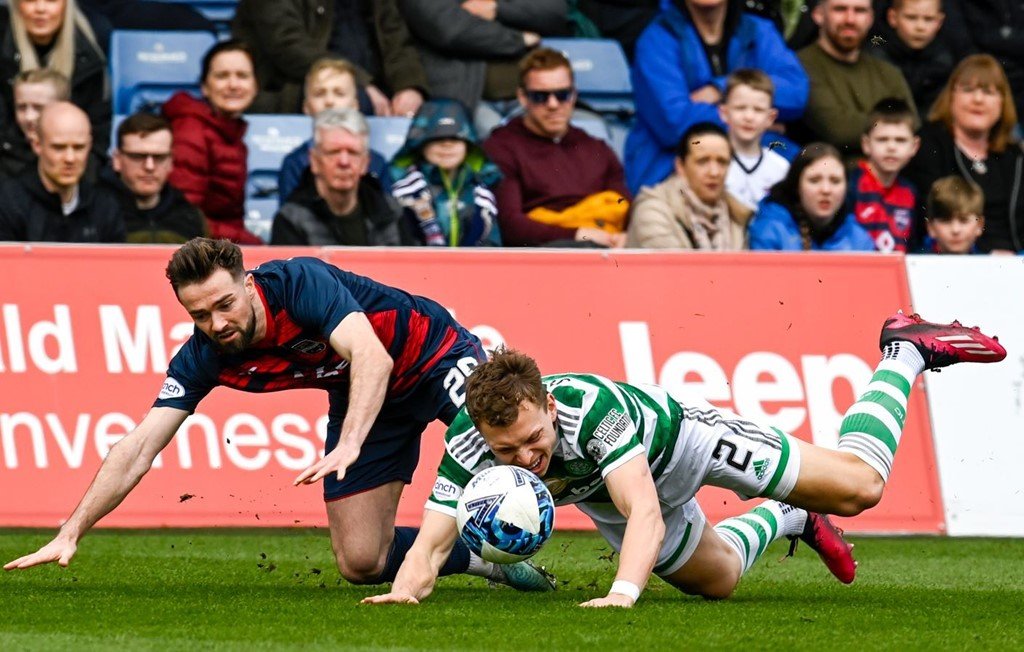Ross County 0-2 Celtic commentary, Although Celtic dominating the first half, County managed to pull through until Alex Iacovitti handled just before halftime, allowing Jota to score from the spot.
Due to this, Malky Mackay’s team was compelled to attack during a second 45-minute period in which both teams had opportunities.
After Ross Callachan’s injury reduced County’s number of players to 10, Alexandro Bernabei fired a late settler.
This means that since the Glasgow rivals drew at Ibrox at the beginning of January, Ange Postecoglou’s team has won 15 straight games going into Saturday’s derby at home against second-placed Rangers.
After suffering their eighth straight loss to Celtic, County is now in last place and four points behind Kilmarnock.
Both coaches gave their generally stable teams unexpected first starts, and Mackay started 16-year-old Dylan Smith in the middle of defence when captain Keith Watson was only cleared to sit on the bench.
The tall adolescent, who had just served with the Scotland Under-17 team, was naturally at the centre of the action as Celtic established their anticipated dominance of possession.
Tomoki Iwata, the on-loan Yokohama F Marinos midfielder who had been brought in to replace injured fellow Japan international Reo Hatate, was in charge of the play as Smith showed assurance beyond his years and captain Callum McGregor had moved further forward.
The anticipated Celtic blitz didn’t materialise, and even though a fierce Greg Taylor shot missed the far post, the breakthrough didn’t occur until a County miscalculation.
Iacovitti called for a handball when he challenged the opposing center-half Carter-Vickers, and referee Willie Collum was already on his way down the tunnel to provide a happy halftime team talk.
The ensuing spot kick was emphatically executed by Jota through the middle, which altered the atmosphere in both locker rooms.
Whatever was said turned the match into a back-and-forth contest, with Celtic goalkeeper Joe Hart having to scramble to stop a low drive from on-loan Wigan Athletic midfielder Gwion Edwards as the home team finally presented an attacking threat.
With only Ross Laidlaw to beat, Kyogo Furuhashi missed the target with his effort, and the hosts’ goalkeeper then made two outstanding saves to save substitute attacker Oh Hyeon-gyu from scoring while Jota’s attempt hit the underside of the crossbar.
Celtic supporters could finally breathe easy as Bernabei’s missile reached the back of the goal late in stoppage time.
County bravery almost pays off – analysis
As County had let up 20 goals in their previous seven consecutive losses to Celtic, it was not surprising that Mackay initially chose a cautious strategy as his team sought to earn their first victory against the champions since February 2021.
It was a risky decision to start the young defender Smith at the centre of the defence, but aside from a few instances in which his inexperience shone during a dramatic finish, he did well to live up to his manager’s faith in him.
The bottom line is that, as a result of Kilmarnock’s victory over Heart of Midlothian on Saturday, Mackay’s team has lost ground in the race for a relegation play-off spot. Mackay’s bold move to throw bodies forward in search of an equaliser nearly paid off, despite the fact that his team had to finish the game with one man down.
Postecoglou will be content with the fact that his team survived one of its toughest home tests this year and that they were able to react after Rangers’ victory the day before.
Although Iwata will face tougher competition, he demonstrated that the Celtic manager has another excellent option in a midfield that is already loaded with ability.
Postecoglou will also be aware that against their championship rivals at Celtic Park, their finishing and deliveries into the penalty box will need to be more accurate.








